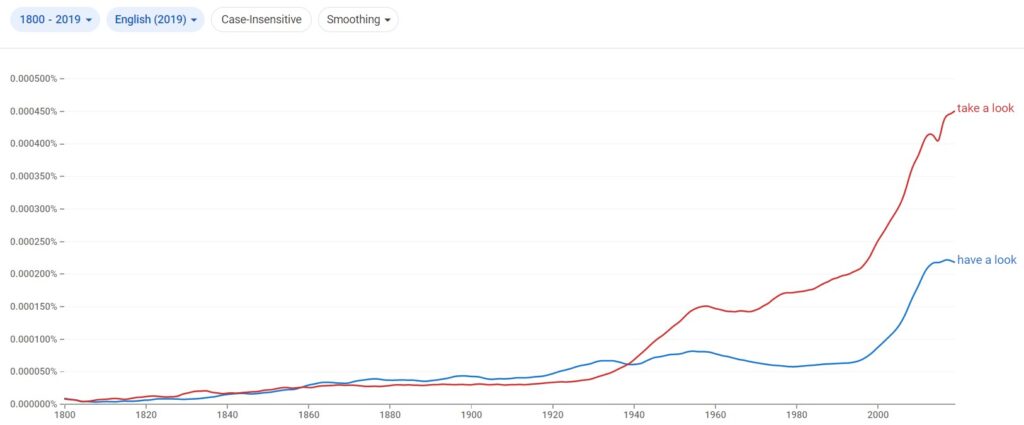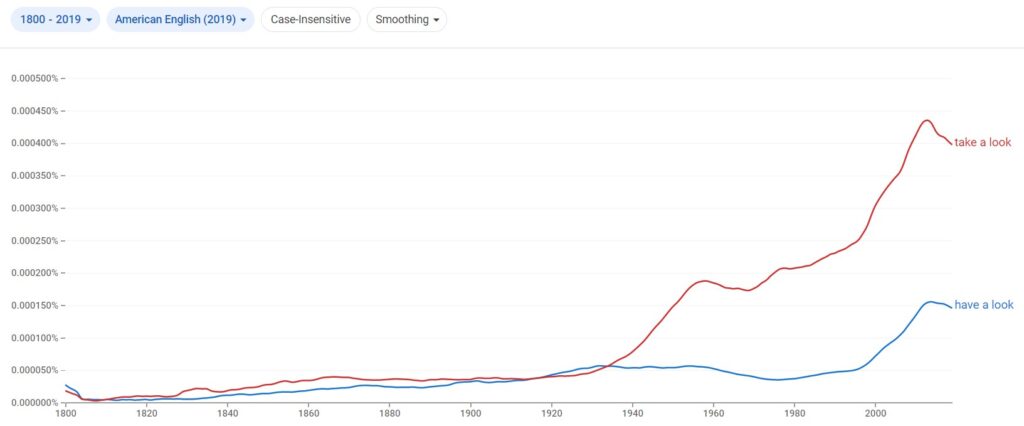Sometimes, we like to keep our speech and writing slightly more formal, including extra words to achieve that. “Have a look” and “take a look” are two great examples of making a sentence more informal. We could simply say “look,” but including the extra words makes it more personal.
What Is The Difference Between “Have A Look” And “Take A Look”?
“Have a look” should be used in British English when you want someone to look at something. “Take a look” should be used in American English but in the same situations as “Have a look”. However, both terms are acceptable in both languages.

You can see on this graph the difference in popularity between the two meanings. While “take a look” is the more popular choice now, they were once equaled around the late-1800s and mid-1900s.

Since “take a look” is more common in American English, it’s no surprise that it surpassed “have a look” in popularity as America is the larger country. Also, Americanisms frequently make their way into the UK and are adopted rather quickly. This is one such example of that because “take a look” is now just as popular in the UK as “have a look” is.
Is “Have A Look” And “Take A Look” Used Differently In American English And British English?
We’ve briefly covered the differences between the two languages, but we thought we’d go a little bit further and show you some evidence. Let’s start with American English.
American English
As you can see from the graph, both phases have some element of recognition to them. However, “take a look” is by far the most popular of the two. It follows a similar trend to the overall graph that we highlighted in the previous sections.

Both sayings are used in American English, though it’s more acceptable and expected to hear someone use “take a look” rather than “have a look.”
British English
Now, if you look at this graph, you’ll see a slightly different trend that speaks to the influence that American English is slowly having over British English.

In the late-1800s and for most of the 1900s, “have a look” was the popular saying in British English. It wasn’t until later in the 1900s that “take a look” started to show up, and even then, it took a few decades before the two were even.
British English has a habit of holding on to the things it knows and finds familiar, which is why there’s such a small divide between the usage of the two phrases. Both “have a look” and “take a look” are about as popular as each other, with “take a look” just taking the victory over the two.
7 Examples Of How To Use “Have A Look” In A Sentence
Let’s see some examples of the two phrases in action. There won’t be much difference between these next two sections because they both have very similar meanings. Still, we thought it would be good for you to see how they’re used in a sentence.
- Have a look at what I got from the shops today!
- Oh my god, have a look at this! I can’t believe my eyes!
- Have a look at what my mother bought me for my birthday.
- Have you had a look at the dinner plans?
- You should have a look at that. It’s not great.
- Has a doctor had a look at that wound? I think it’s infected.
- We need to have a closer look at that! Wow!
We can use “have a look” in various ways and utilize any tense we want. The context isn’t necessary. The idea is to simply make the text slightly more colloquial (or informal). It’s mostly used when we speak to friends and family.
Look at these examples:
- Look at what I got from the shops.
- Have a look at what I got from the shops.
We include “have a look” as a way to encourage someone to look at something, which keeps it informal. If we simply say “look,” like in the first example, then it almost seems like a command or order. That’s reserved for more formal situations and shouldn’t be used casually.
7 Examples Of How To Use “Take A Look” In A Sentence
“Take a look” is used to pretty much the same degree as “have a look,” so we won’t bore you with any extra details. Let’s just see it in action!
- Take a look at these awesome new trainers I bought!
- Take a look at that. I can’t believe my eyes!
- Have you taken a look at the new rota?
- Take a look at the route I have to take to get to my new school!
- You should take a look at that when you get a minute. You won’t regret it.
- We should take a look together. That way, there are no surprises.
- Are you ready to take a quick look with me?
We can always include an adjective before “look” to emphasize our meaning slightly further. For example, we can say “take a closer look” or “take a quick look.” Both of the phrases have a similar meaning, and the adjectives are used more as emphasizing words rather than descriptive words.
Even though “quick” implies you have to do something with speed, it doesn’t have to mean that in this context.
Is “Have A Look” Or “Take A Look” Formal?
As we’ve mentioned above, neither of these phrases is formal. If you want to use something like this in a formal situation, then you’re better off simply sticking to the command word “look.”
Removing “have a” or “take a” from the beginning of the phrase is enough to make it a formal command. However, there are still better alternatives that you might be able to use.
Some good alternatives for formal speaking include:
- Would you mind looking at this?
We want to start most formal speaking or writing with a question to indicate a desire to look at something.
- Do you care to look at this?
Again, another question that gently nudges someone to look at something in a more formal tone.
Which Prepositions Can Be Used After “Have A Look” And “Take A Look”?
Let’s look at a few of the most common prepositions we can use after “have a look” or “take a look.” Both of the phrases are interchangeable, so we’ll only include the prepositions that follow.
At
“At” is by far the most common preposition that comes directly after “look” in either of those phrases. It’s the preposition that indicates the direction that someone should look and works perfectly.
- Have a look at that!
- Take a look at those!
With
If we’re talking about “having a look” or “taking a look” with another person, then we use the preposition “with” after them to show that. There are always two or more people present in this case.
- You should have a look with me.
- You should take a look with me.
In
If we’re directing someone’s attention to look inside of something, then we would follow “look” with the preposition “in.”
- Have a look in the box!
- Take a look in the shed!
“Have A Look” And “Take A Look” – Synonyms
There are plenty of alternatives that we could cover to use instead of one of these two words. We thought it would be best to show you some of the equally casual synonyms that work really well instead of these two.
- Check it out
Instead of “have a look” or “take a look,” “check it out” works really well and doesn’t come with any differences between American and British English. It’s a casual way of someone asking you to look at something they’re interested in.
- Have you seen this?
Another great casual question that comes up a lot when someone wants to show another person something of interest.
What Does It Mean To Take A Closer Look?
When we use the word “closer” in the middle of “take a look,” we’re using an adjective more as a modifier than a descriptive word. It’s mostly there to add emphasis over anything else.
“Take a closer look” means to really show an interest in looking at something. You can spend more time looking at the thing to really analyze it and understand why someone wanted you to look at it in the first place.
Usually, this saying is used when someone is blown away by what they’re looking at and want you to have a look yourself.
What Does “We Will Have A Look At It And Get Back To You” Mean?
You might hear a saying like this if you’ve recently contacted a company about a job. If you’ve asked them to look at your CV or resume, they could say, “they will have a look at it and get back to you.”
“Have a look at it and get back to you” means that someone needs time to look over something. Once they’re done looking over it, they will respond to you with their answer (or whatever is necessary to respond).
You might also like: “I Will Look Into It”: Here’s What It Actually Means (+12 Examples)
